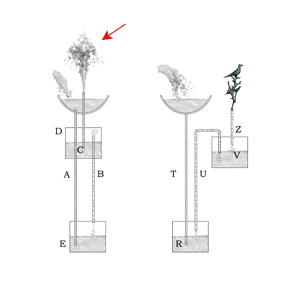Gushing fountain
Treatises composed in Alexandria from the 3rd century BC on contain many descriptions of fountains with surprise effects, which soon appeared in the gardens and on the tables of those eager to amaze their guests. Described by Hero around the mid-1st century AD, but certainly already known to Philo of Byzantium if not also Ctesibius (3rd century BC), this apparatus functions as follows: fill container D with water and then start pouring the liquid into the top cup. Tube A conveys the water to recipient E at the base, pushing out the air and forcing it into pipe B. On reaching container D, the air exercises thrust on the water, forcing it to rise inside pipe C and gush out.




